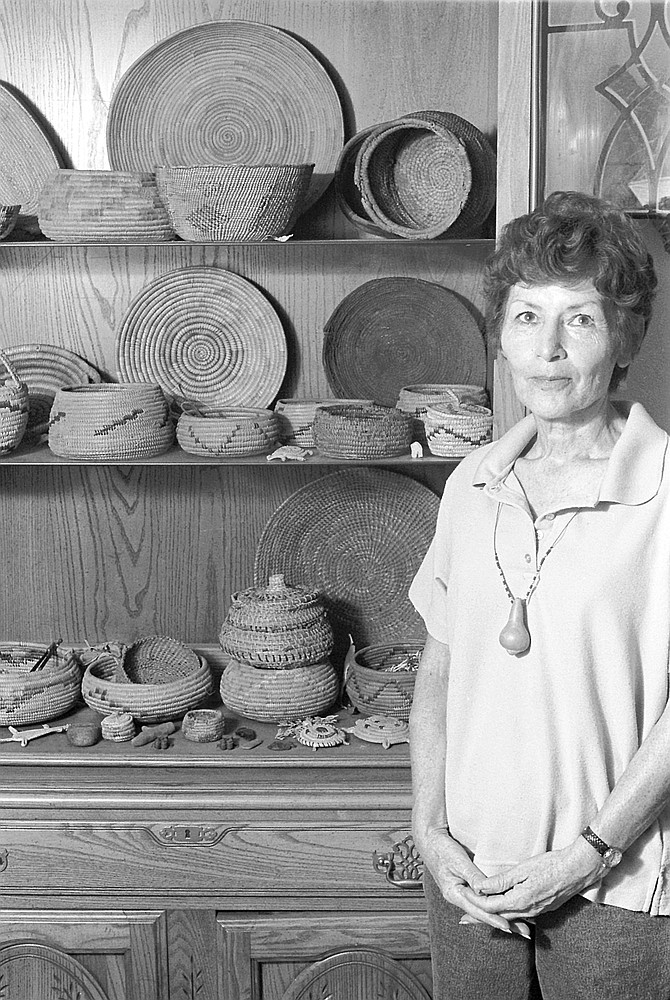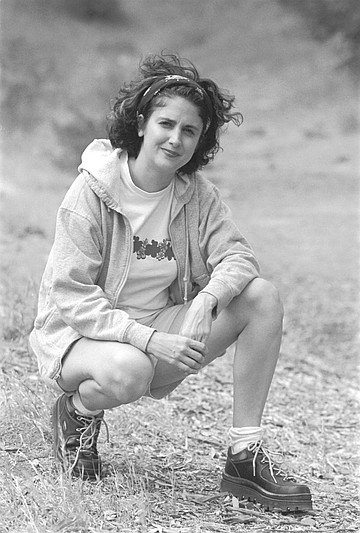 Facebook
Facebook
 X
X
 Instagram
Instagram
 TikTok
TikTok
 Youtube
Youtube

“The Kumeyaay weren’t an agricultural people,” says Heather Rosing, who, as a hobby, has studied the culture of the Native Americans indigenous to San Diego. “They were hunters and gatherers — mainly gatherers — who moved around. They had uses for over 12,000 plants in our area alone — either food or medicinal uses.
Acorns were their biggest food source, Rosing says of the so-called Indians of the Oak. From them they made breads, soups, puddings, and other dishes for over half their calories. Along the Piedras Pintadas Interpretive Trail in the San Dieguito River Park, volunteers have created a replica of a Kumeyaay kitchen. It’s a configuration of large rocks. “In the rock itself are dips and grooves,” says Rosing, a volunteer guide. “The largest groove is called a basin, the deepest a mortar. They would grind food in these with a pestle.” Nuts, reptiles, and rodents all became a paste before being cooked over a fire. “Typically one kitchen would be used by five or six women. They were communal kitchens.

Other aspects of Kumeyaay life were communal. “They didn’t own parcels of land, but did have one pseudo property right — the acorn tree. Often, a tree would be owned by a family and passed down. Uncommon but not unknown were acorn wars, when tribes would fight over the rights to acorn trees.” Hikers who accompany Rosing on a four-mile loop this weekend will see acorn trees — California live oaks. They will also see plant material the Kumeyaay used to make their renowned baskets. (Another name for the Kumeyaay is Basket Makers.) “The three-leaved sumac — that’s there on the trail — but not the juncus and the deer grass. Many native plants were lost when exotic species were brought in by the Spaniards.”
Rosing will talk about how the Kumeyaay built their homes. “They lived in huts, for lack of a better word— domes made of willow frames thatched with deer weed and yucca fiber.” Deer weed is still everywhere on the trail, she says.
Proud of her library of 25 books about the Kumeyaay, Rosing, who works as a lawyer, believes it includes just about every volume published on the subject. But she readily defers to someone like Daleane (“Dee”) Adams, who is three-eighths Kumeyaay, and who knows about Kumeyaay culture from living it. Adams knows particularly its gourd crafts. “I’ve been around gourds all my life,” says this enrolled member of the Jamul Indian Village in East County.
Adams remembers how the tribe danced with gourd rattles. “We never used drums” — at least not until tourists started expecting them. “That’s because when you put on a powwow nowadays, the people come to hear drums and singing and to see the fancy feathers, like Indians wear in Oklahoma. Those are what they associate with all Indians. But we didn’t use drums and never wore fancy feathers. We didn’t live in teepees or kill a buffalo. There are no buffalo out here.”
Adams’s grandmother, named Isabell Thing, made gourd rattles. “I have a rattle that belonged to her — a very simple gourd with a bird she painted on it.” Of her own success with gourd crafts, people have told Adams: “Well, you got that gift from your grandmother.”
Isabell Thing was famous in San Diego as a medicine woman, says Adams. “She was a full-blooded Indian originally from around Balboa Park and was well-respected by all the local reservations as a healing woman who used the native plants to do her medicine work.”
Gourd-rattle makers must have deft hands — and a tuned ear. “We make holes in the gourd and put dried seeds in. When you have the right sound, you seal the holes closed.”
Beyond their ceremonial uses, gourds once had practical uses, too. “Whenever the Kumeyaay traveled, they carried food in their gourd containers, and they made canteens of them, so they would have water when they went into the desert.”
Being melon-family members, gourds need a large growing space to sprawl, which Adams, who lives near the stadium, lacks. She gets — or, you might say, gathers — hers at a gourd farm in Temecula. She’ll be there this week stocking up for this Saturday’s class at Mission Trails Regional Park, where her students will learn ornamental uses for gourds. They’ll make bowls and vases for dried flowers and decorate them with authentic Kumeyaay designs. “But I’ll also show them that some gourds are too pretty to mess up with paint. Just scoop it out and leave it at that. Let the natural beauty of the gourd come through.” Gourd crafts last “forever,” Adams promises, “if you don’t drop them.” Treat them like pottery, she advises. Noting that the Kumeyaay are part of a universal gourd-craft culture, she says, “Gourds have been dug up from thousands of years ago — they were buried with the Egyptians. They have been found all over the world.”


“The Kumeyaay weren’t an agricultural people,” says Heather Rosing, who, as a hobby, has studied the culture of the Native Americans indigenous to San Diego. “They were hunters and gatherers — mainly gatherers — who moved around. They had uses for over 12,000 plants in our area alone — either food or medicinal uses.
Acorns were their biggest food source, Rosing says of the so-called Indians of the Oak. From them they made breads, soups, puddings, and other dishes for over half their calories. Along the Piedras Pintadas Interpretive Trail in the San Dieguito River Park, volunteers have created a replica of a Kumeyaay kitchen. It’s a configuration of large rocks. “In the rock itself are dips and grooves,” says Rosing, a volunteer guide. “The largest groove is called a basin, the deepest a mortar. They would grind food in these with a pestle.” Nuts, reptiles, and rodents all became a paste before being cooked over a fire. “Typically one kitchen would be used by five or six women. They were communal kitchens.

Other aspects of Kumeyaay life were communal. “They didn’t own parcels of land, but did have one pseudo property right — the acorn tree. Often, a tree would be owned by a family and passed down. Uncommon but not unknown were acorn wars, when tribes would fight over the rights to acorn trees.” Hikers who accompany Rosing on a four-mile loop this weekend will see acorn trees — California live oaks. They will also see plant material the Kumeyaay used to make their renowned baskets. (Another name for the Kumeyaay is Basket Makers.) “The three-leaved sumac — that’s there on the trail — but not the juncus and the deer grass. Many native plants were lost when exotic species were brought in by the Spaniards.”
Rosing will talk about how the Kumeyaay built their homes. “They lived in huts, for lack of a better word— domes made of willow frames thatched with deer weed and yucca fiber.” Deer weed is still everywhere on the trail, she says.
Proud of her library of 25 books about the Kumeyaay, Rosing, who works as a lawyer, believes it includes just about every volume published on the subject. But she readily defers to someone like Daleane (“Dee”) Adams, who is three-eighths Kumeyaay, and who knows about Kumeyaay culture from living it. Adams knows particularly its gourd crafts. “I’ve been around gourds all my life,” says this enrolled member of the Jamul Indian Village in East County.
Adams remembers how the tribe danced with gourd rattles. “We never used drums” — at least not until tourists started expecting them. “That’s because when you put on a powwow nowadays, the people come to hear drums and singing and to see the fancy feathers, like Indians wear in Oklahoma. Those are what they associate with all Indians. But we didn’t use drums and never wore fancy feathers. We didn’t live in teepees or kill a buffalo. There are no buffalo out here.”
Adams’s grandmother, named Isabell Thing, made gourd rattles. “I have a rattle that belonged to her — a very simple gourd with a bird she painted on it.” Of her own success with gourd crafts, people have told Adams: “Well, you got that gift from your grandmother.”
Isabell Thing was famous in San Diego as a medicine woman, says Adams. “She was a full-blooded Indian originally from around Balboa Park and was well-respected by all the local reservations as a healing woman who used the native plants to do her medicine work.”
Gourd-rattle makers must have deft hands — and a tuned ear. “We make holes in the gourd and put dried seeds in. When you have the right sound, you seal the holes closed.”
Beyond their ceremonial uses, gourds once had practical uses, too. “Whenever the Kumeyaay traveled, they carried food in their gourd containers, and they made canteens of them, so they would have water when they went into the desert.”
Being melon-family members, gourds need a large growing space to sprawl, which Adams, who lives near the stadium, lacks. She gets — or, you might say, gathers — hers at a gourd farm in Temecula. She’ll be there this week stocking up for this Saturday’s class at Mission Trails Regional Park, where her students will learn ornamental uses for gourds. They’ll make bowls and vases for dried flowers and decorate them with authentic Kumeyaay designs. “But I’ll also show them that some gourds are too pretty to mess up with paint. Just scoop it out and leave it at that. Let the natural beauty of the gourd come through.” Gourd crafts last “forever,” Adams promises, “if you don’t drop them.” Treat them like pottery, she advises. Noting that the Kumeyaay are part of a universal gourd-craft culture, she says, “Gourds have been dug up from thousands of years ago — they were buried with the Egyptians. They have been found all over the world.”
Comments